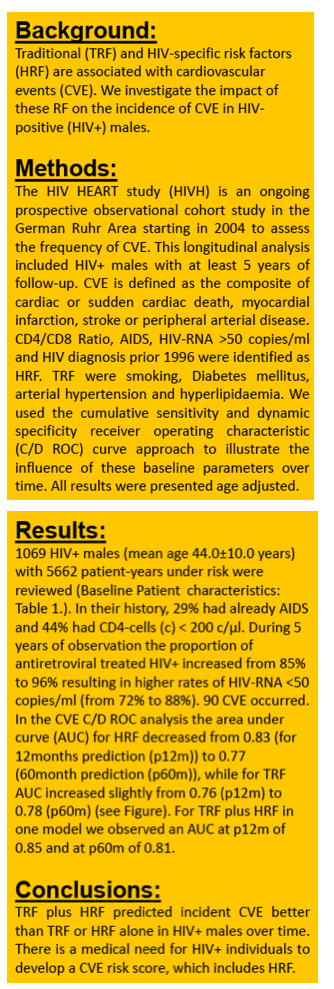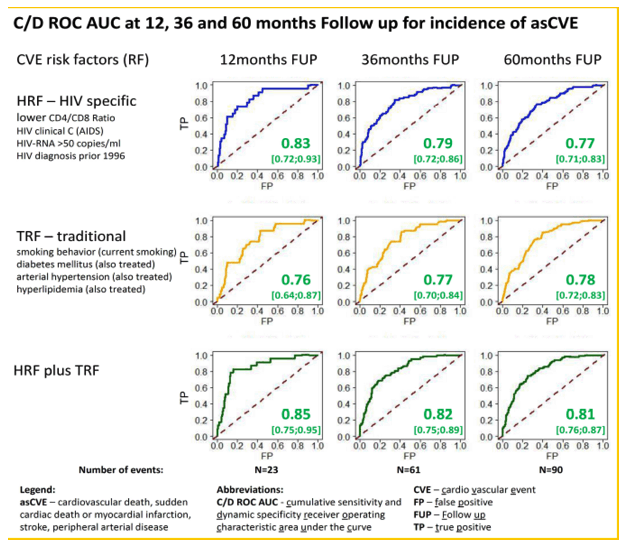 |
 |
 |
| |
Better Predictive Power When Combining Traditional and HIV-Specific Cardio Risk Factors – "Impact of HIV specific and traditional risk factors on the incidence of cardiovascular events in HIV-positive males over time"
|
| |
| |
10th IAS Conference on HIV Science (IAS 2019), July 21-24, 2019, Mexico City
Mark Mascolini
A 1069-person analysis of HIV-positive men in Germany found that combined traditional and HIV-specific cardiovascular risk factors predicted clinical cardiovascular outcomes (events) better than either traditional or HIV-specific risk factors alone [1]. HIV HEART Study researchers called for development of a cardiovascular risk score that includes both HIV-specific and traditional risk factors.
Standard cardiovascular risk scores for the general population fall short in predicting clinical cardiovascular disease--or "cardiovascular events"--in people with HIV. One likely reason for this failure is that people with HIV have HIV-specific cardiovascular risk factors not shared by the general population. HIV HEART Study investigators analyzed data from their ongoing observational cohort to assess the predictive power of traditional risk factors, HIV-specific risk factors, and the two sets combined.
Launched in 2004, the HIV HEART Study aims to assess the frequency of cardiovascular events in people with HIV. The researchers define cardiovascular events as combined cardiac or sudden cardiac deaths, myocardial infarction, stroke, and peripheral arterial disease. They considered 4 HIV-specific cardiovascular risk factors: CD4/CD8 ratio, AIDS, viral load above 50 copies, and HIV diagnosis before 1996. Traditional risk factors were smoking, diabetes, arterial hypertension, and abnormal lipids. To assess the impact of HIV-specific and traditional risk factors on cardiovascular events, the investigators used cumulative sensitivity and dynamic specificity receiver operating characteristic (C/D ROC) curves. They adjusted all results for age.
The analysis focused on HIV-positive men in the HIV HEART Study who had at least 5 years of follow-up since entering that cohort. The 1069 HIV-positive men identified averaged 44 years in age, averaged 64 months of follow-up, had 5662 person-years at risk during follow-up, and had taken antiretrovirals for a median of 102 months. Whites made up a large majority of the study group, 93%. While 44% of men had a CD4 count below 200 at some point, 29% had a clinical AIDS diagnosis. During 5 years of follow-up, the proportion of men taking antiretroviral therapy rose from 85% to 96%, while the proportion with a viral load below 50 copies climbed from 72% to 88%.
The most frequent traditional cardiovascular risk factors were history of hyperlipidemia in 69%, high total cholesterol in 62%, high triglycerides in 58%, current smoking in 54%, and high low-density lipoprotein cholesterol in 46%. During follow-up, researchers recorded 90 cardiovascular events.
At 12 months of follow-up, area under the curve (AUC) for C/D ROC stood at 0.83 for HIV-specific risk factors, at 0.76 for traditional risk factors, and at 0.85 for combined HIV-specific and traditional risk factors. (AUCs closer to 1.0 indicate better predictive power.) At 36 months of follow-up, C/D ROC AUC was 0.79 for HIV-specific risk factors, 0.77 for traditional risk factors, and 0.82 for combined HIV-specific and traditional risk factors. At 60 months of follow-up, C/D ROC AUC measured 0.77 for HIV-specific risk factors, 0.78 for traditional risk factors, and 0.81 to combined risk factors.
At all three follow-up points, combined HIV-specific and traditional cardiovascular risk factors predicted cardiovascular events better than either set of factors alone. The HIV HEART Study team stressed the medical need for a cardiovascular risk score that includes HIV-specific factors.
Reference
1. Reinsch N, Schulze C , Holzendor V, et al. Impact of HIV specific and traditional risk factors on the incidence of cardiovascular events in HIV-positive males over time. 10th IAS Conference on HIV Science (IAS 2019), July 21-24, 2019, Mexico City. Abstract TUPEB203. For e-poster: https://programme.ias2019.org//PAGMaterial/eposters/3099.pdf

N. Reinsch1, C. Schulze2 , V. Holzendorf3, S. Dolff4, H. Streeck5, N. H. Brockmeyer6, A. Potthoff6, M. Hower7, K-H. Jöckel8, B. Schmidt8, S. Esser2 on behalf of HIV HEART Study Group
1Department of Internal Medicine I and Cardiology, Devision of Electrophysiology, Alfried Krupp Hospital, Essen, Germany and University Witten/Herdecke, Witten, Germany; 2Clinic of Dermatology, Department of Venereology, University Hospital Essen, Essen, Germany; 3Clinical Trial Centre Leipzig - Coordination Centre for Clinical Trials (ZKS Leipzig - KKS), University Leipzig, Germany; 4Department of Infectious Diseases, University Hospital Essen, University Duisburg-Essen, Essen, Germany; 5Institute for HIV Research, University Hospital Essen, University Duisburg-Essen, Essen, Germany; 6Germany Clinic of Dermatology, Venerology and Allergology, Center for Sexuell Health and Medizin Ruhruniversity Bochum, Bochum, Germany; 7ID-Outpatient-Clinic, City Hospital Dortmund, Internal Medicine, Dortmund, Germany; 8Institute for Medical Informatics, Biometry and Epidemiology (IMIBE), University Hospital Essen, Essen, Germany



|
| |
|
 |
 |
|
|